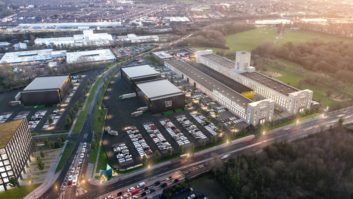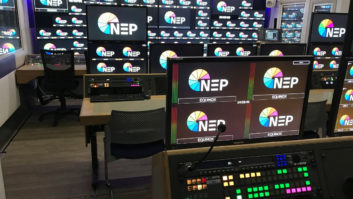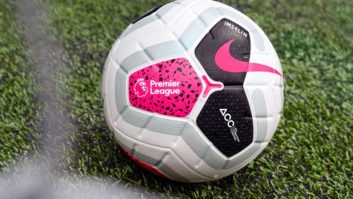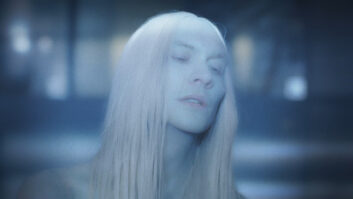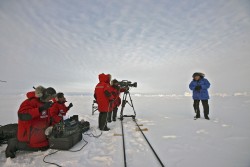
The BBC’s latest natural history series has won worldwide acclaim. Philip Stevens discovers some of the technical aspects to its success.
First, just a few fascinating facts: the series was four years in production, the crew spent 2356 days in the field, 1.5 years at sea, over six months on the sea ice and 134 hours filming under the ice. The result has been a spectacular set of programmes produced by the BBC under the series title of Frozen Planet.
The series gives a portrait of the four seasons at, what is generally considered, the last great wilderness on earth, the Polar Regions. Covering both animal life and vegetation, the production team used a mixture of shooting techniques to portray the Arctic and Antarctic as they have never been seen before – and, indeed, may never be seen again.
Renowned naturalist and broadcaster Sir David Attenborough, who himself travelled to both Polar Regions in the making of the series, provided the voice over for the series.
“Obviously, one of the problems with making such programmes is the distances involved,” says Mark Linfield, one of the BBC’s producers on the series. “For example, because of the logistics and expense it is simply impractical to carry out reconnaissance trips in the way that we usually do. As a result, we have to draw upon the extremely helpful knowledge of those who have visited the regions. In addition, there is a group of polar experts who provide invaluable advice.”
The other understandable area of potential difficulties is the weather. In order to predict what might happen to cameras and other pieces of equipment, the assistance of a huge cold store near Bristol was sought. “We took the kit into an area that normally holds items such as frozen baguettes and beef burgers,” reveals Linfield.
“Although it is hard to predict exactly what we would encounter in the Polar Regions, this exercise allowed us to see the type of problems we might potentially face. At low temperatures, moving parts can freeze and cables can become so stiff they snap. Following the tests, we were able to winterise the equipment. Some of the modifications included mini-heaters on servos on the motion control units and special ‘arctic cabling’ that would stay flexible in the cold.”
Linfield reports that these preparations meant there were surprisingly few weather-related problems on location.
A mixture of tape, hard drive, digital SLR, 35mm and Super 16mm film cameras were employed for the shoots. “It’s a case of using the best technique for individual circumstances,” says Linfield. “For instance, for static time lapse we found the digital stills camera gave us the best results. The underwater sequences involved a variety of Sony cameras and Panasonic VariCams were used for most behavioural shooting on land.”
One spectacular time lapse sequence involved a panning shot across a specific polar landscape at the various seasons of the year. To achieve the best results, the team decided to use 35mm film. “This was the only medium that allowed us to accomplish long exposure time lapse, realtime and high speed shooting in a single unit. In this way and using motion control, we created a moving sequence that showed the seasonal changes from the same location at different times of the year. Once the first set of passes was finished, we deployed metal markers to record the exact position of the tripod. When we came back at the next season, we used GPS to give us the rough location of the markers, then a metal detector to get us even closer, finally we sank the tripod into the original metal markers.”
During the intervening period, the permafrost could have moved slightly, or snow may have appeared on the scene, so there was always a possibility that the next sequence might not match exactly the previous filming. However, care in setting the positioning of the equipment meant any mismatches would be minimal.
“One of the benefits of using film is that the resolution allows us to re-align the shots to provide us with a perfect match,” declares Linfield. “The result is a memorable panning sequence that shows the four seasons merging into each other without any jumps in the movement. I do not believe we could have achieved that incredible effect with HD tape.”
Stable images
Arial sequences were shot on Sony 1500 hard disk cameras mounted in 5-axis gyro-stabilisation units manufactured by Cineflex. This company also provided the robotics for controlling the cameras. Helicopter shots were especially useful in obtaining images of animals that might have been scared off by the close proximity of a production crew. Having a stabilised mount also enabled the helicopter to remain some distance from the animals – again to prevent them from becoming frightening.
The same camera rigs were mounted on motorised dinghies used to capture close ups of polar bears and other animals.
“In summer, the sea ice is continually breaking up and moving around,” explains Linfield. “Standing on the ice is, therefore, a risky business. The only way to get close-ups of some of these animals is from a boat. However, boats are notoriously unsteady, so the stabilisation units are essential in obtaining good, useable shots. By using a counterbalanced arm for the camera mounts and the robotic controls, we were able to pick up all the close ups we needed.”
In fact, this pioneering use of the aerial camera, this time mounted on to the yacht, plus a second stabilised camera and a polecam enabled the crew to capture multiple angles of killer whales attacking seals in Antarctica. Similarly, by mounting a stabilised camera on a trawler, the team recorded some spectacular views of the melting ice world of the Arctic in summer. During this particular exercise, there was a close encounter with a hunting female polar bear, which came within 15 feet of them.
Once the filming was completed, all the material was brought back to the BBC’s Natural History Unit at Bristol, where editing was carried out on Final Cut Pro 7. “We have been very pleased with the result. There’s a great deal of hard work and commitment, but it is truly worth it,” concludes Linfield.
And a great many others seem to share Linfield’s delight. Alongside being shown on the BBC in the UK, the programmes have now been sold to international broadcasters in Australia, Japan, Belgium, Finland, South Africa, New Zealand, Netherlands, Italy, Denmark, Norway, Russia and Sweden. A book and DVD of the series has recently been published.
www.bbc.co.uk
www.panasonic.com
www.sony.co.uk
www.cineflexv14hd.com
